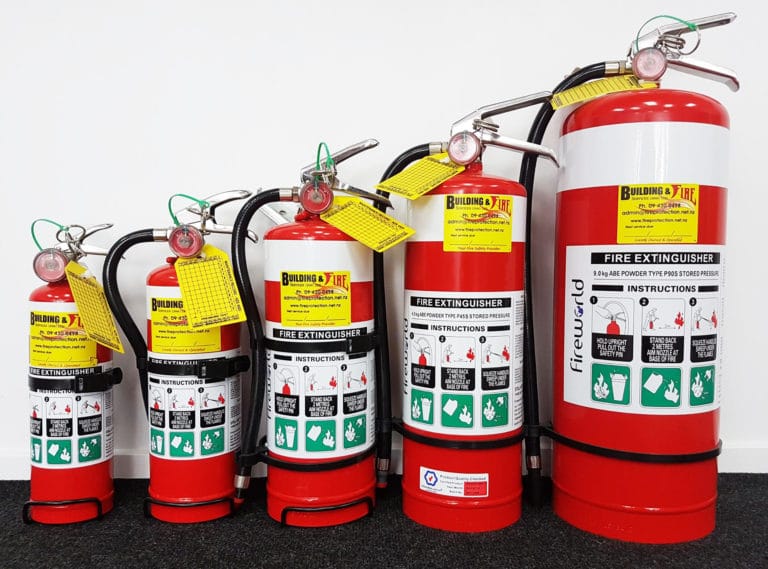Know Your Bands from Your Classes: Choosing the Right Fire Extinguisher for You
Your co-worker is yelling at you from the office kitchen. You run to see that a fire has broken out from the old toaster you’ve all been using for years. The fire is small and you feel it is safe to try to extinguish it. There are three fire extinguishers side-by-side in the main foyer of the building and another in the break room. Which do you choose? How do you use it? Time is of the essence. Would you feel safe trying to put this fire out yourself?
Experience tells us that the initial apprehension people feel when approaching a fire is an issue for businesses and homes alike. We’d all like to think we know how we’ll behave in a real event. The aim of this post is to give you the know-how and the confidence to extinguish a small fire when it is safe to do so.
Before attempting to deal with the fire yourself think RACE
- Remove – all persons from immediate danger, if safe to do so.
- Alert – all occupants of the danger, includes staff, public, visitors. You can do this both verbally and you must also operate/turn on the nearest Fire Alarm Call point and then Dial 111. Note if there is any number needed to access an outside line (or use your mobile).
- Confine – IF SAFE TO DO SO and you have time – close any doors and windows in your area, this inclues smoke or fire doors. This can stop the spread of smoke and also slows the oxygen flow to the fire
- Evacuate the building or area to a Safe place or IF SAFE TO DO SO extinguish the fire using a suitable Extinguisher, providing you are trained and confident to do so.
Know your class: Not all extinguishers are the same
In fact, there are 6 classes of fire.
Class A: (Wood paper plastics)
Class B: (Flammable & combustible liquids)
Class C: (Flammable gases)
Class D: (Fires involving combustible metals)
Class E: (Electrically energised equipment)
Class F: (Cooking oils and fats)
Choosing the correct fire extinguisher for you also means choosing the correct extinguisher for the class of fire likely to affect you.
There are 5 types of fire extinguisher, each with a specific use for one or more of the above classes of fire:
- Dry powder extinguishers (identified by a white band) ABE dry powder extinguishers are suitable for all types of fires except cooking oils and fats.
- Carbon dioxide extinguishers (identified by a black band) are suitable for use where the fire is located close to electrically energised equipment as they are non-conductive, clean and safe. These extinguishers have a horn at the end of the hose. Due to the extreme cold of the carbon dioxide that is expelled from the extinguisher, it should not be touched.
- Water extinguishers (no colour band) are only really suitable for use in tackling freely burning materials such as paper, cloth, wood and furniture. They should not be used against flammable and combustible liquids (e.g. oil and petroleum) or cooking oils and fats as the water will merely spread the flames.
- Foam extinguishers (identified by a blue colour band) are characterised by their simple method of operation. They are ideal for fires involving flammable liquids.
- Wet Chemical extinguishers (identified by an oatmeal colour band) are ideal for freely burning materials such as paper, cloth, wood and furniture and with cooking oil and fat fires. It is dangerous to use these Fire Extinguishers on live electrical equipment.
Deciding which extinguisher you require will involve a risk assessment. Which fire dangers are most likely in your location?
This easy to understand guide clearly shows which extinguisher is used for which class of fire and should help you in your decision.
So, you now have the correct fire extinguisher in your hand. Your co-worker continues to shout at you for a solution. How do you know if it is safe to use an extinguisher in this situation?
Again think RACE
- Remove – all persons from immediate danger, if safe to do so.
- Alert – all occupants of the danger, includes staff, public, visitors. You can do this both verbally and you must also operate/turn on the nearest Fire Alarm Call point and then Dial 111. Note if there is any number needed to access an outside line (or use your mobile).
- Confine – IF SAFE TO DO SO and you have time – close any doors and windows in your area, this inclues smoke or fire doors. This can stop the spread of smoke and also slows the oxygen flow to the fire
- Evacuate the building or area to a Safe place or IF SAFE TO DO SO extinguish the fire using a suitable Extinguisher, providing you are trained and confident to do so.
You approach the mini-inferno in your office kitchen and are ready to tackle the flames but, do you know how to use the extinguisher correctly?
PASS:
- Pull the safety pin or remove the clip.
- Aim the nozzle at the base of the fire from a safe distance. Most extinguishers are designed to be operated from about 2 – 3 metres away.
- Squeeze the handles.
- Sweep the extinguisher from side to side while aiming at the base of the fire.
As you can see, it’s not enough to know which fire extinguisher you need, it is also important to know how to assess a situation to decide if it is safe to use it and understand the best method to extinguish the fire safely.
 Back
Back
 Back
Back